WILLY T. RIBBS–30 YEARS


WHERE TRADITION NEVER STOPS

BORG-WARNER–85 YEARS

The Borg-Warner Trophy is one of the most recognizable prizes in all of sports. It’s art, speed and elegance all wrapped in one that has chronicled every moment of the Indianapolis 500 that it has witnessed.
Check back next week to learn about the trailblazing tale of Willy T. Ribbs.


The story of Willy T. Ribbs is one that many can relate to, and certainly one that everyone can appreciate. This is a story about breaking barriers; a story about resolve, toughness and bravery.
This is the story of a modern-day trailblazer.


– WILLY T. RIBBS


Ribbs first made history at the Indianapolis Motor Speedway in 1985 when he became the first Black man ever to drive official laps around the legendary Speedway when he attempted Rookie Orientation Program in the AMI Racing Division entry owned by Sherman Armstrong, though it did not result in an Indy 500 qualifying attempt.

He returned in 1991 with Derrick Walker to drive the No. 17 Walker Motorsports Lola. His journey was anything but easy, and it became one of the most dramatic weeks for a single driver in “500” history.
But it’s those odds-defying accomplishments that turn moments into history and drivers into legends.
Ribbs arrived at Indianapolis in April to complete his Rookie Orientation Program. Driving a year-old chassis that featured an old Cosworth engine, the car was lacking speed. Walker Motorsports lost the first five days of on-track action as they switched to Buick engines, and Ribbs turned his first laps on Day 6.
The next day, Friday, May 10, the car suffered the first of what would be six engine failures that month, including five in next eight days. The initial failure forced them to sit out the first weekend of qualifying.
The coming days proved to be one of the most back-and-forth, up-and-down weeks a driver could possibly withstand. One day, Ribbs would set one of the top speeds of the day. The next, a cloud of smoke trailed his yellow and red machine. Sometimes, it even happened
on the same day.
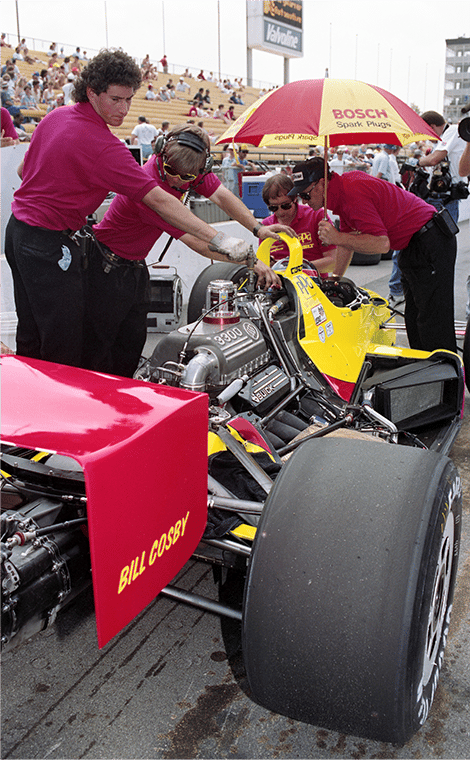


– WILLY T. RIBBS

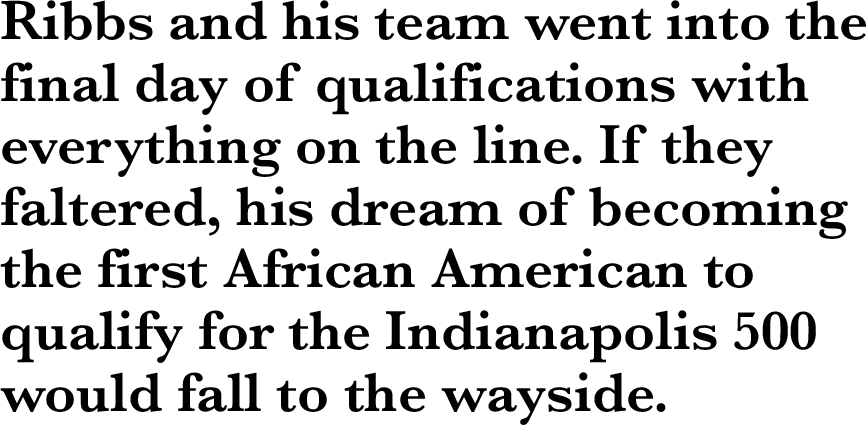
Ribbs and his team went into the final day of qualifications with everything on the line. If they faltered, his dream of becoming the first African American to qualify for the Indianapolis 500 would fall to the wayside.

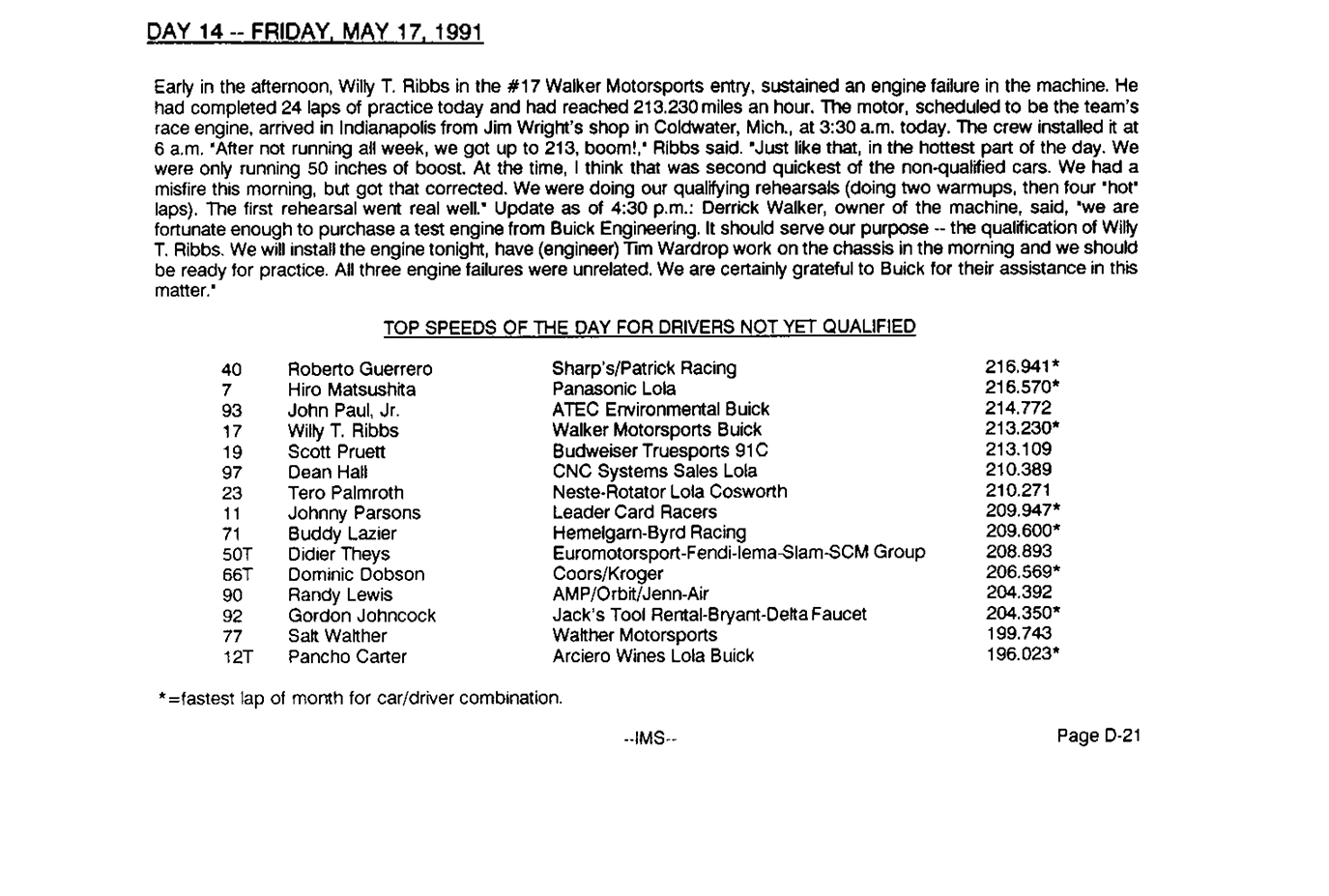



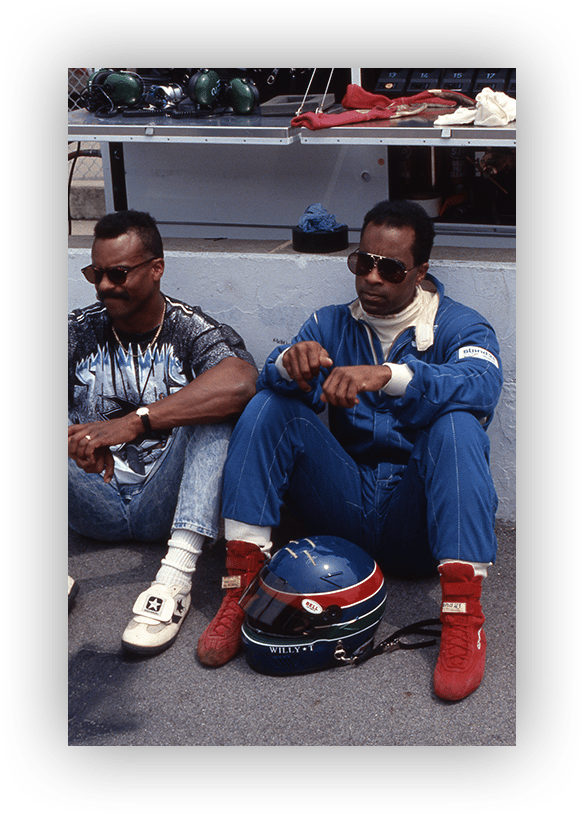
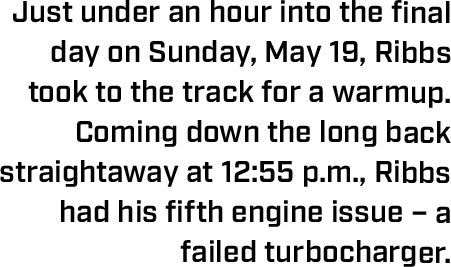
Just under an hour into the final day on Sunday, May 19, Ribbs took to the track for a warmup. Coming down the long back straightaway at 12:55 p.m., Ribbs had his fifth engine issue – a failed turbocharger.
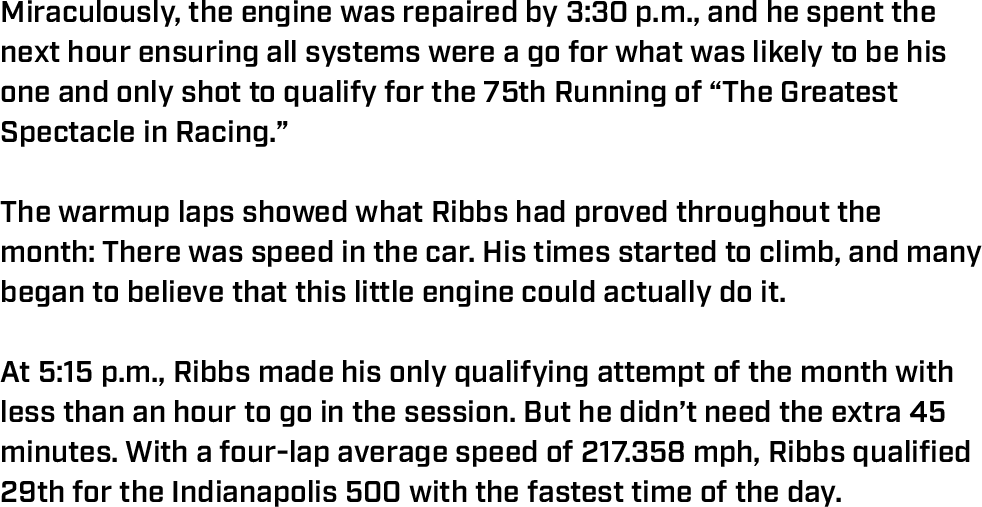
Miraculously, the engine was repaired by 3:30 p.m., and he spent the next hour ensuring all systems were a go for what was likely to be his one and only shot to qualify for the 75th Running of “The Greatest Spectacle in Racing.”
The warmup laps showed what Ribbs had proved throughout the month: There was speed in the car. His times started to climb, and many began to believe that this little engine could actually do it.
At 5:15 p.m., Ribbs made his only qualifying attempt of the month with less than an hour to go in the session. But he didn’t need the extra 45 minutes. With a four-lap average speed of 217.358 mph, Ribbs qualified 29th for the Indianapolis 500 with the fastest time of the day.
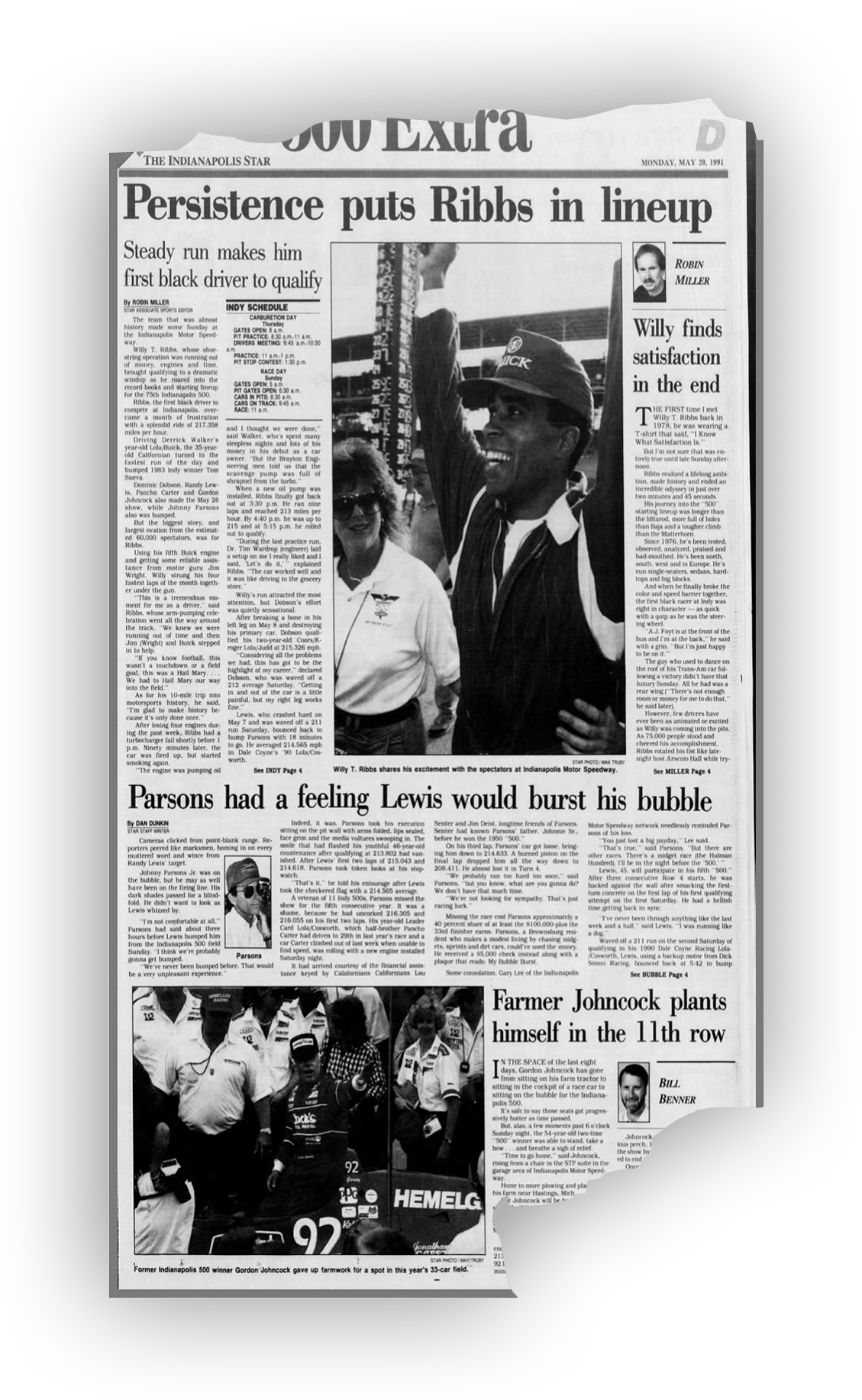
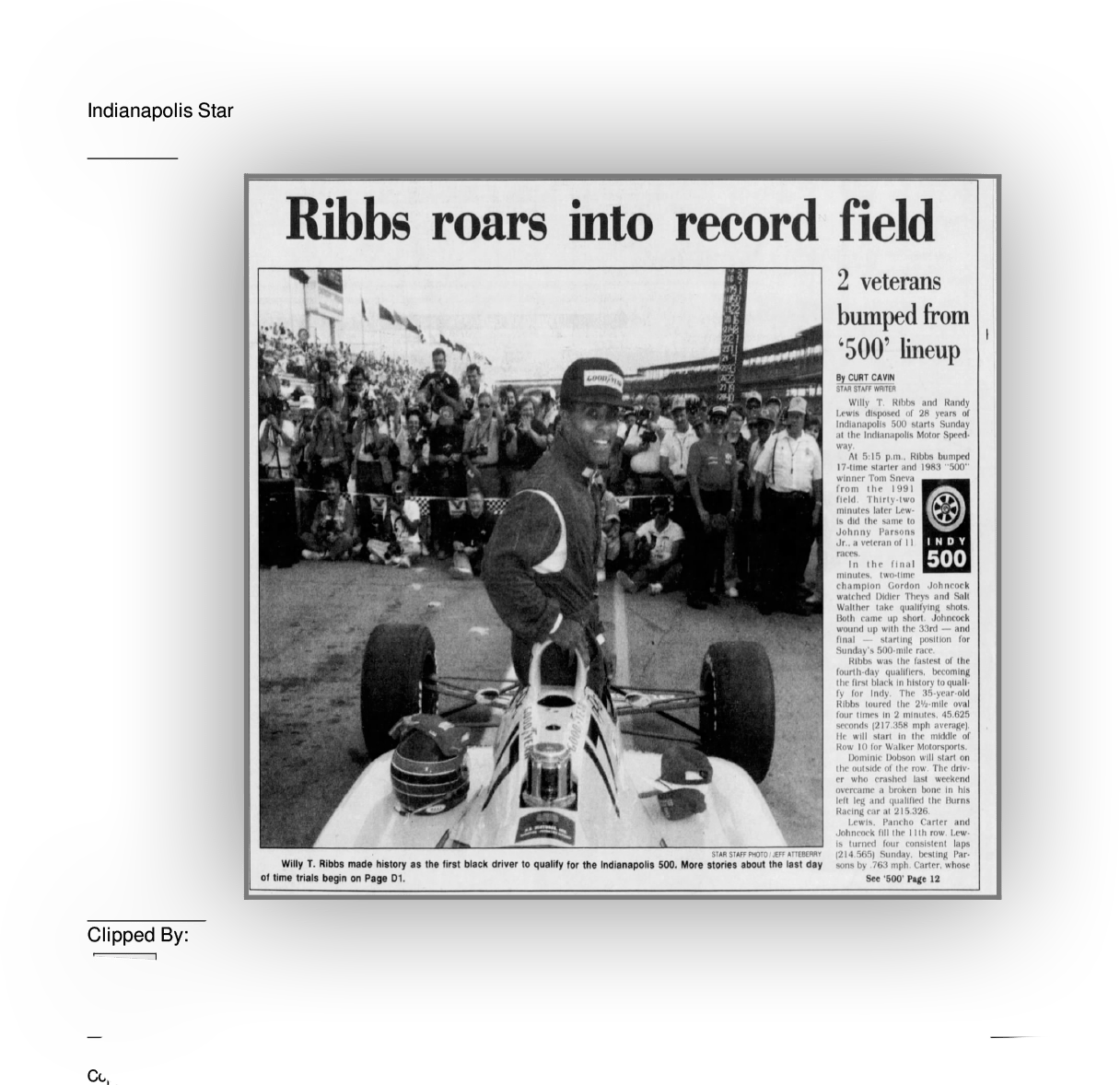

Ribbs can recall in perfect detail what that four-lap qualifying run was like. A faulty radio meant no communication with his team, and for 2 minutes, 45 seconds it was just man and machine.
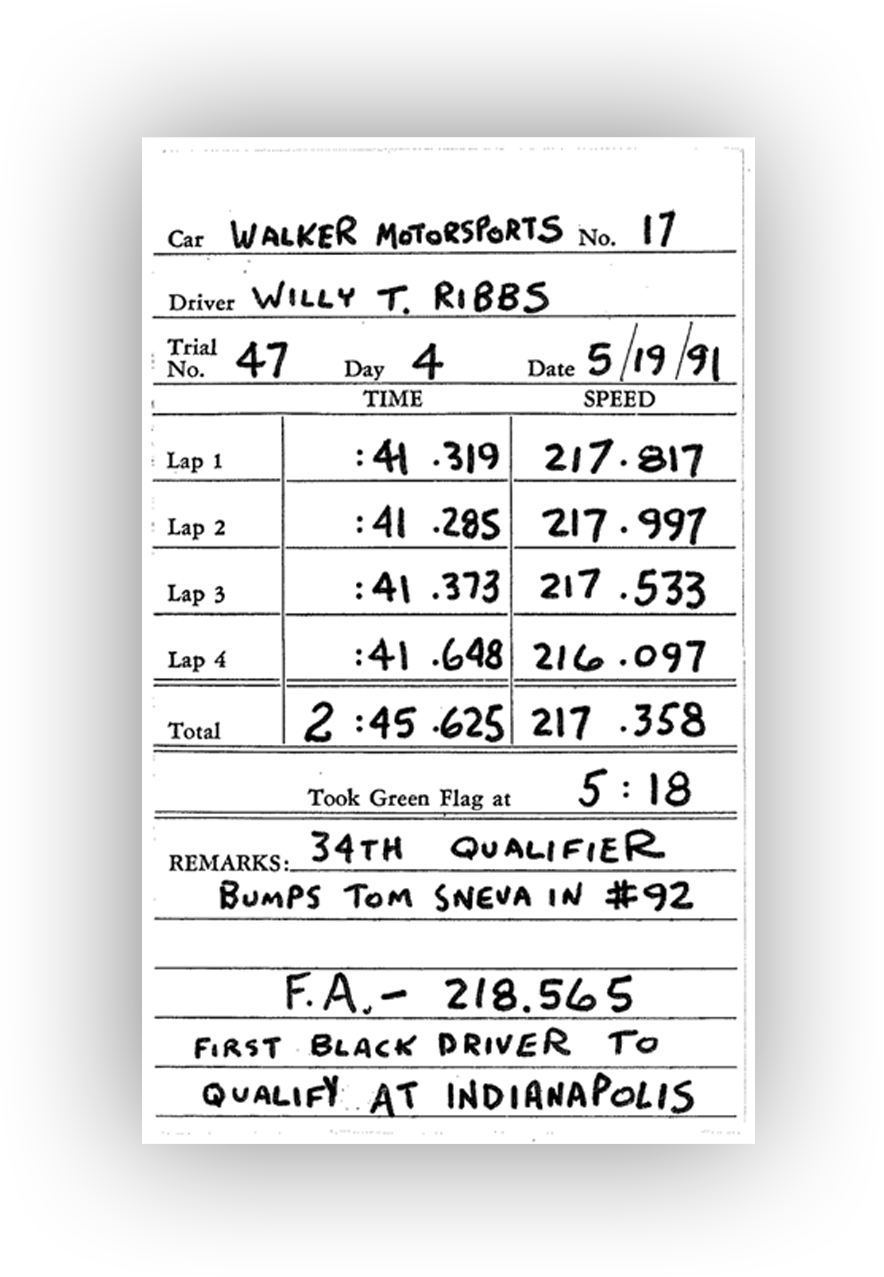



He relied on the pit board to show him his lap times, and he knew his target time for making the field. After he passed the blur of the checkered flag, the fans let him know what he had just accomplished.


– WILLY T. RIBBS

– WILLY T. RIBBS
What followed was one of the most iconic celebrations in Speedway history. Ribbs coasted down pit road hanging out of his race car, cheering emphatically and high-fiving anyone who dare get close. He was greeted by a crowd of crew members and officials eager to celebrate his achievement. One of the most notable: Mari Hulman George, IMS chairperson of the board.
v

The celebration lived on for another week when Ribbs took the green flag for the race on Sunday, May 26. But it didn’t last long. The No. 17 was plagued by engine issues yet again, and by Lap 5, Ribbs’ day was done thanks to his sixth engine problem. He finished 32nd.
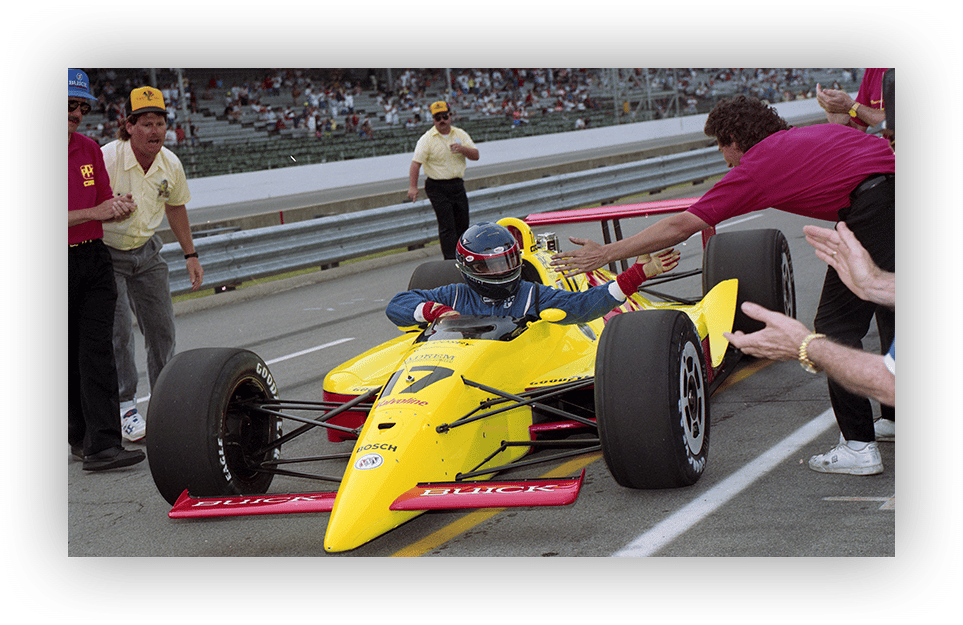




Ribbs returned to IMS with Walker Motorsports in 1993 for another shot at the Indianapolis 500. Driving the No. 75, he qualified 30th and finished 21st. With that finish, Ribbs broke his own record for the best finish by an African American driver in the Indianapolis 500.

CAPPING A CAREER
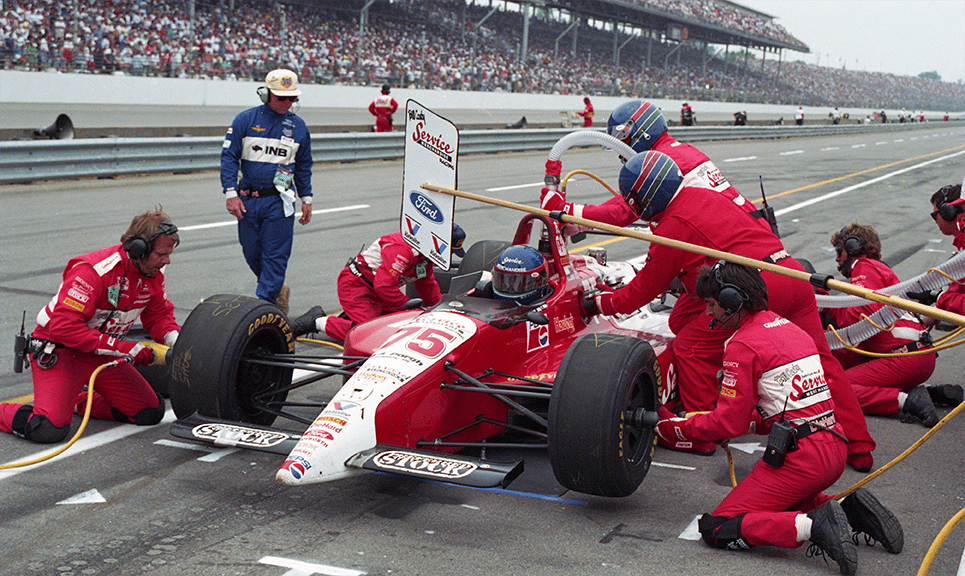
That put his name alongside Black racers Ribbs looked up to. Names like Joie Ray, Charlie Wiggins, Rajo Jack and countless other African American racing pioneers who never got the opportunity to compete at Indianapolis.
It was a record that stood for nine years until George Mack finished 17th in 2002.
As long as “The Greatest Spectacle in Racing” is around, Ribbs will always be first. He is the driver who opened the door for other African Americans that will come to Indianapolis in the future looking to build on his foundation.

– WILLY T. RIBBS
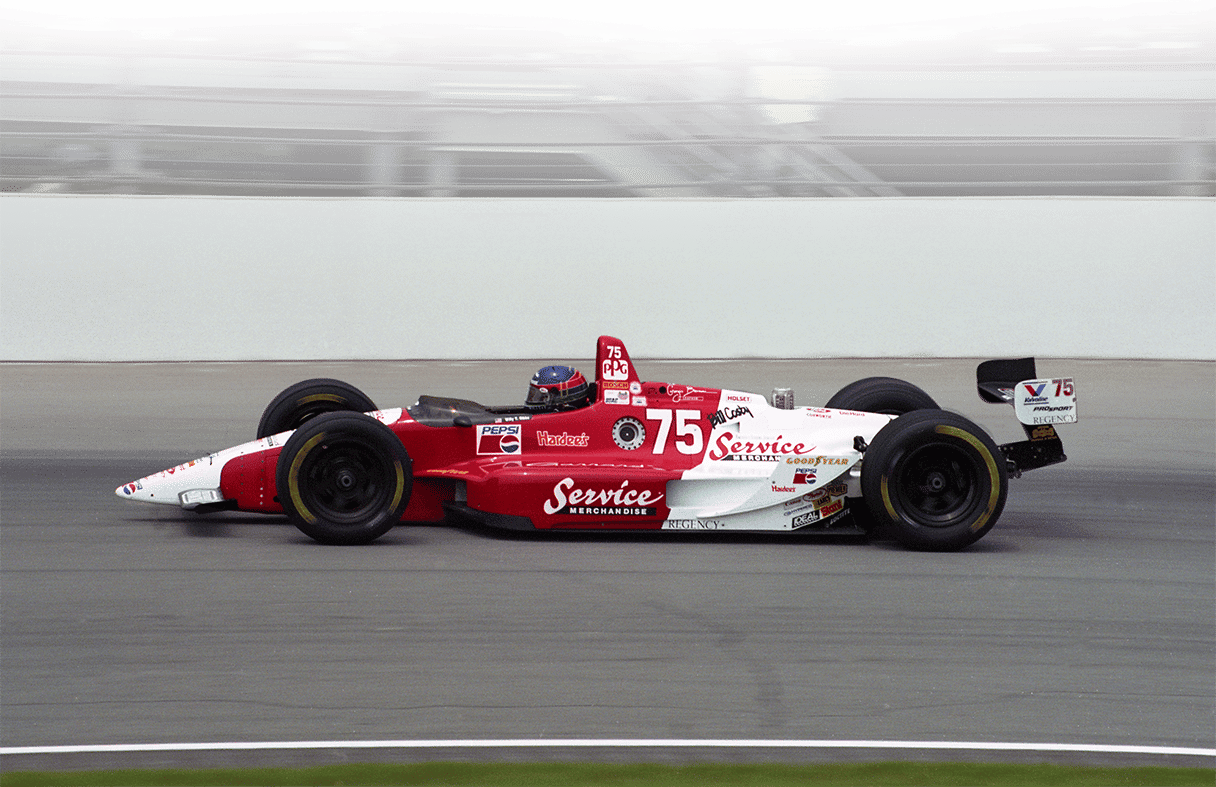
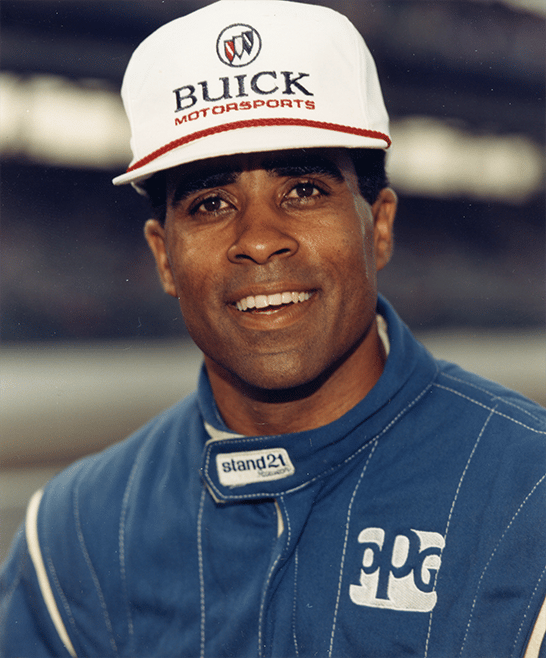


WHERE TRADITION NEVER STOPS

BORG-WARNER–85 YEARS





That put his name alongside Black racers Ribbs looked up to. Names like Joie Ray, Charlie Wiggins, Rajo Jack and countless other African American racing pioneers who never got the opportunity to compete at Indianapolis.
It was a record that stood for nine years until George Mack finished 17th in 200.
CAPPING A CAREER







– willy t. ribbs

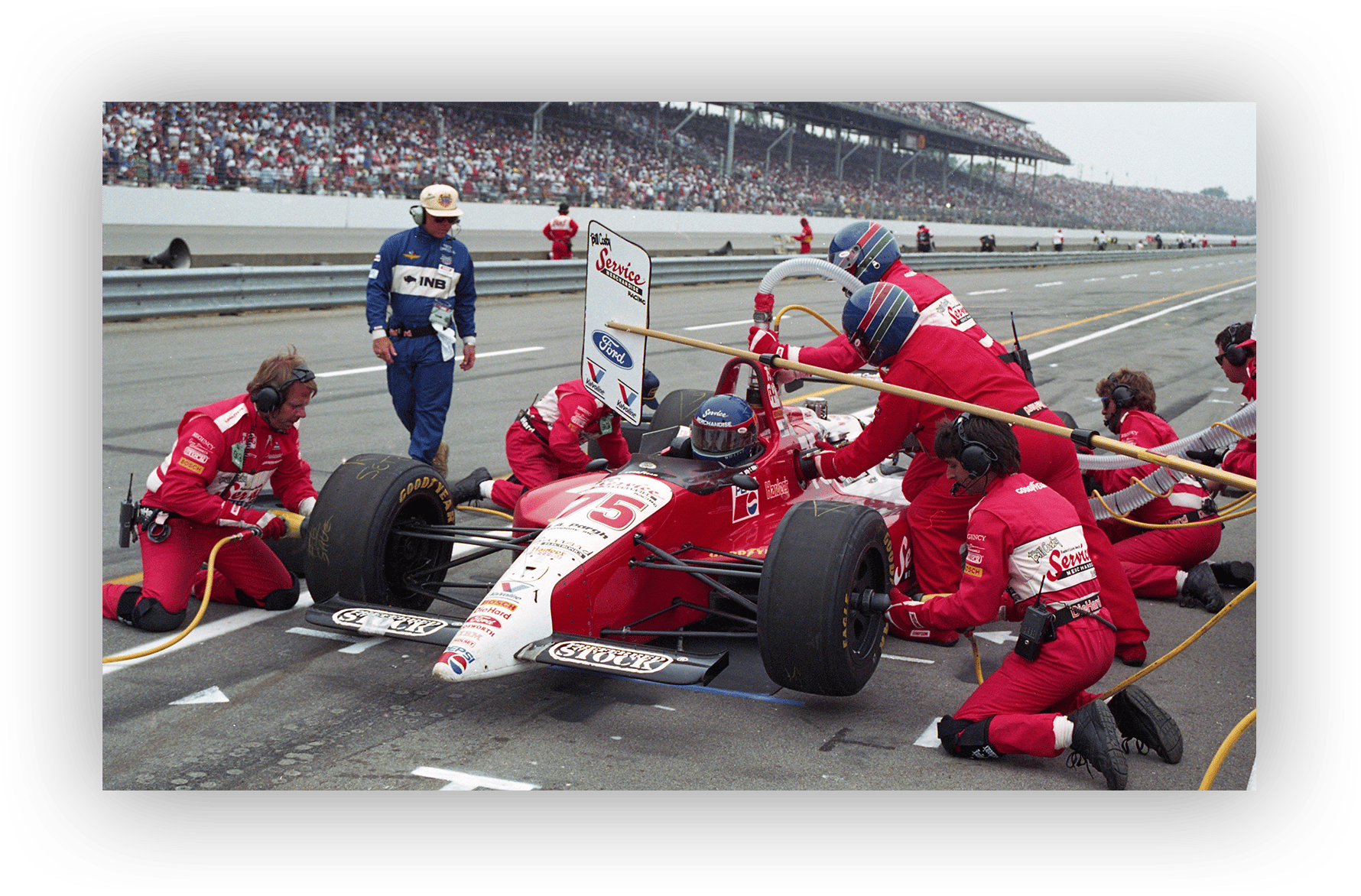
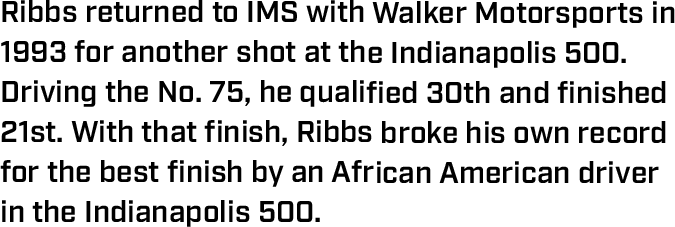
Ribbs returned to IMS with Walker Motorsports in 1993 for another shot at the Indianapolis 500. Driving the No. 75, he qualified 30th and finished 21st. With that finish, Ribbs broke his record for the best finish by an African American driver in the Indianapolis 500.

That put his name alongside Black racers Ribbs admired. Names like Joie Ray, Charlie Wiggins, Rajo Jack and countless other African American racing pioneers who never got the opportunity to compete at Indianapolis.

As long as “The Greatest Spectacle in Racing” is around, Ribbs will always be first. He is the driver who opened the door for other African Americans that will come to Indianapolis in the future looking to build on his foundation.

CAPPING A CAREER

It was a record that stood for nine years until George Mack finished 17th in 2002.


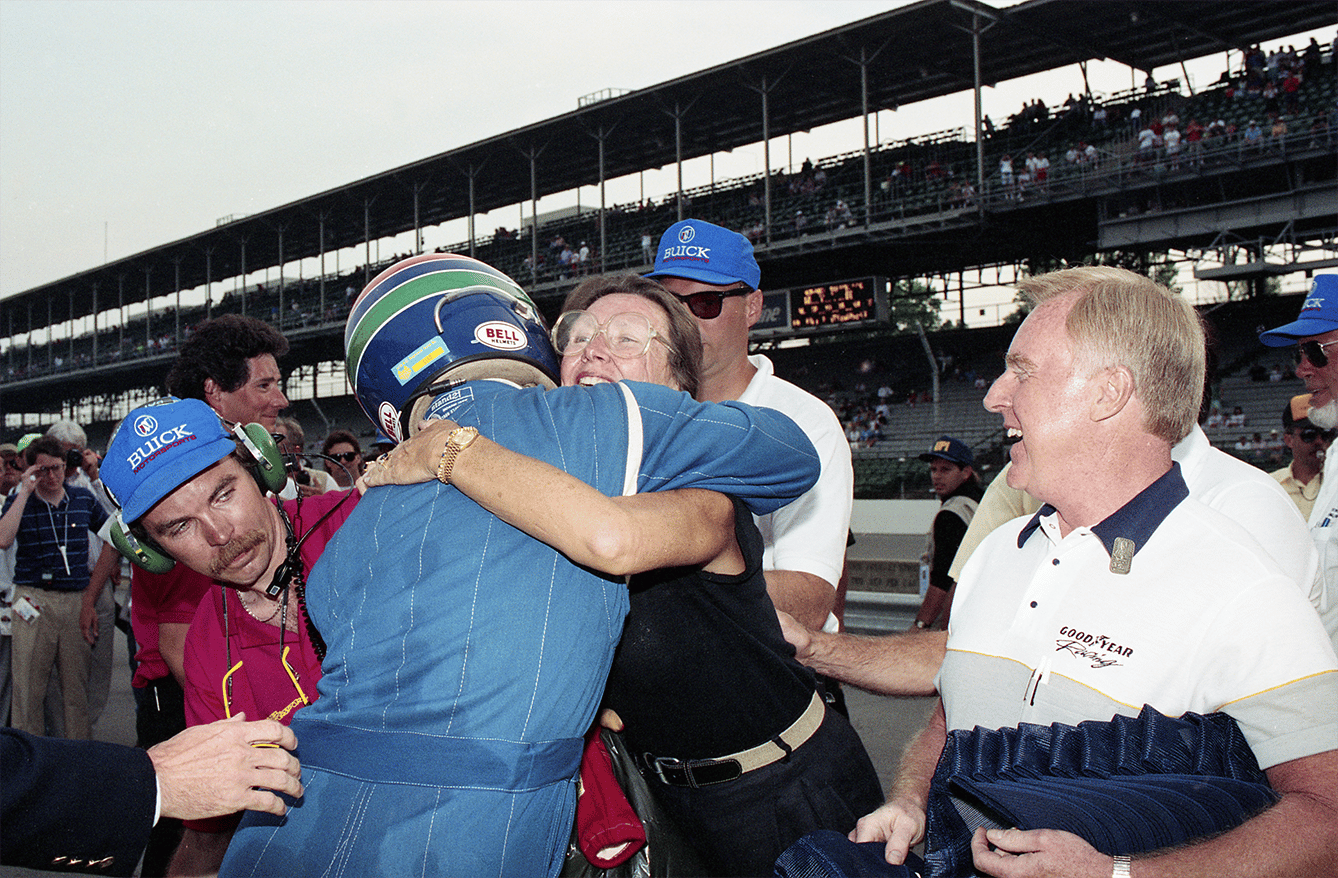
The celebration lived on for another week when Ribbs took the green flag for the race on Sunday, May 26. But it didn’t last long. The No. 17 was plagued by engine issues yet again, and by Lap 5, Ribbs’ day was done thanks to his sixth engine problem. He finished 32nd.

What followed was one of the most iconic celebrations in Speedway history. Ribbs coasted down pit road hanging out of his race car, cheering emphatically and high-fiving anyone who dare get close. He was greeted by a crowd of crew members and officials eager to celebrate his achievement. One of the most notable: Mari Hulman George, IMS chairperson of the board.

– willy t. ribbs

– willy t. ribbs




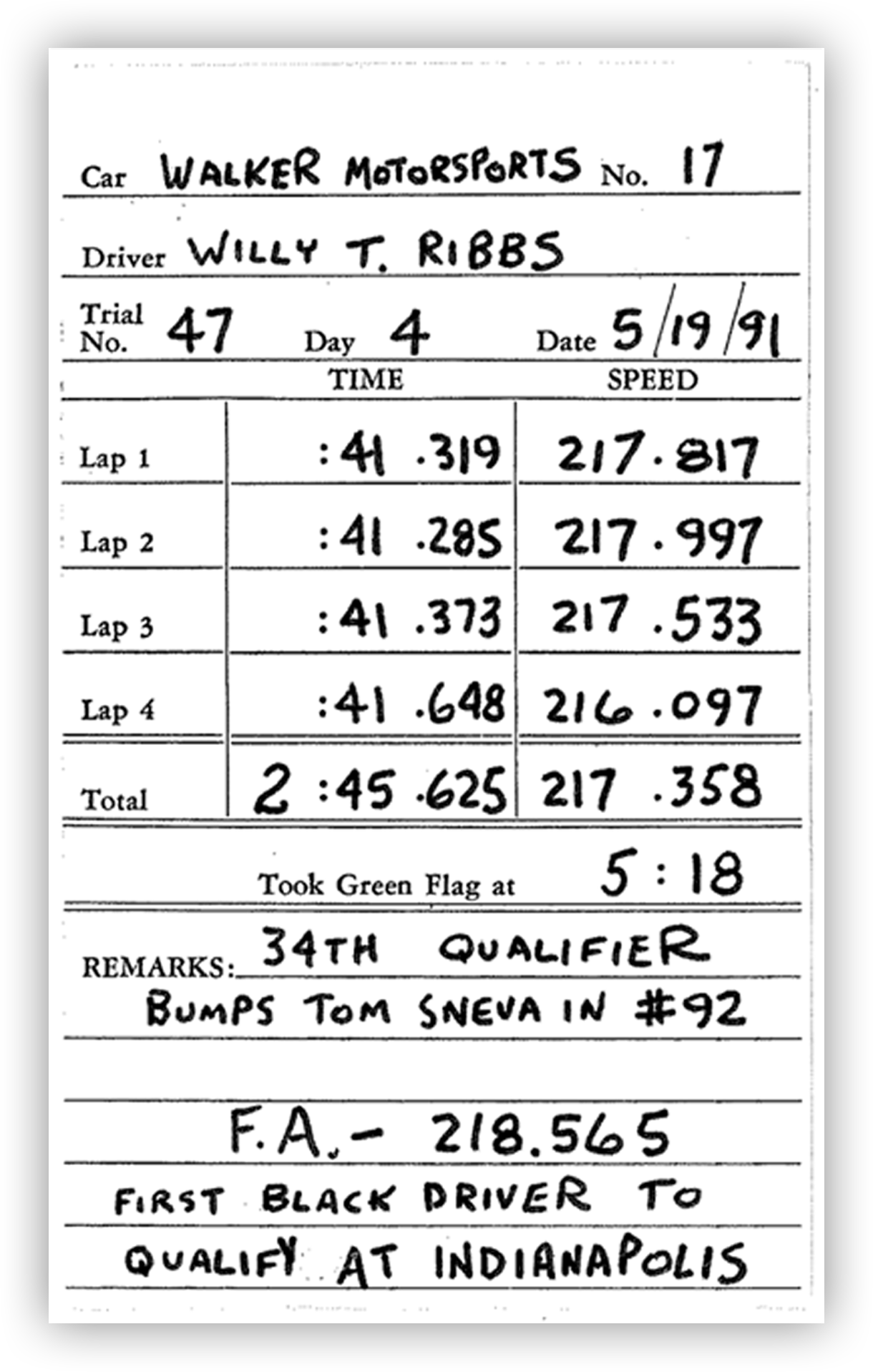

Ribbs can recall in perfect detail what that four-lap qualifying run was like. A faulty radio meant no communication with his team, and for 2 minutes, 45 seconds it was just man and machine.

He relied on the pit board to show him his lap times, and he knew his target time for making the field. After he passed the blur of the checkered flag, the fans let him know what he had just accomplished.
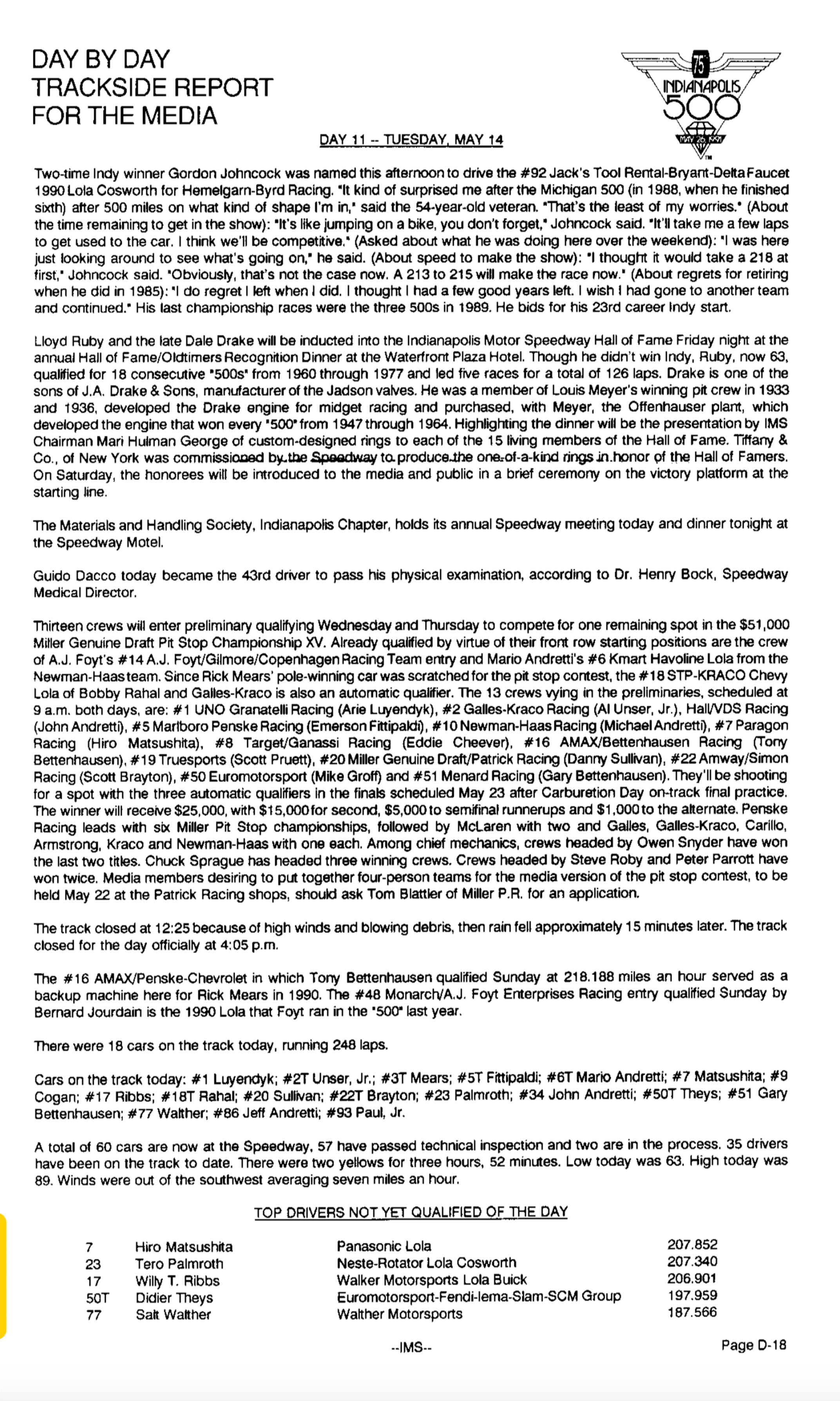



Ribbs and his team went into the final day of qualifications with everything on the line. If they faltered, his dream of becoming the first African American to qualify for the Indianapolis 500 would fall to the wayside.
Just under an hour into the final qualifying day on Sunday, May 19, Ribbs took to the track for a warmup. Coming down the long back straightaway at 12:55 p.m., Ribbs had his fifth engine issue –
a failed turbocharger.
Miraculously, the engine was repaired by 3:30 p.m., and he spent the next hour ensuring all systems were a go for what was likely to be his one and only shot to qualify for the 75th Running of “The Greatest Spectacle in Racing.”
The warmup laps showed what Ribbs had proved throughout the month: There was speed in the car. His times started to climb, and many began to believe that this little engine could actually do it.
At 5:15 p.m., Ribbs made his only qualifying attempt of the month with less than an hour to go in the session. But he didn’t need the extra 45 minutes. With a four-lap average speed of 217.358 mph, Ribbs qualified 29th for the Indianapolis 500 with the quickest time of the day.


– willy t. ribbs
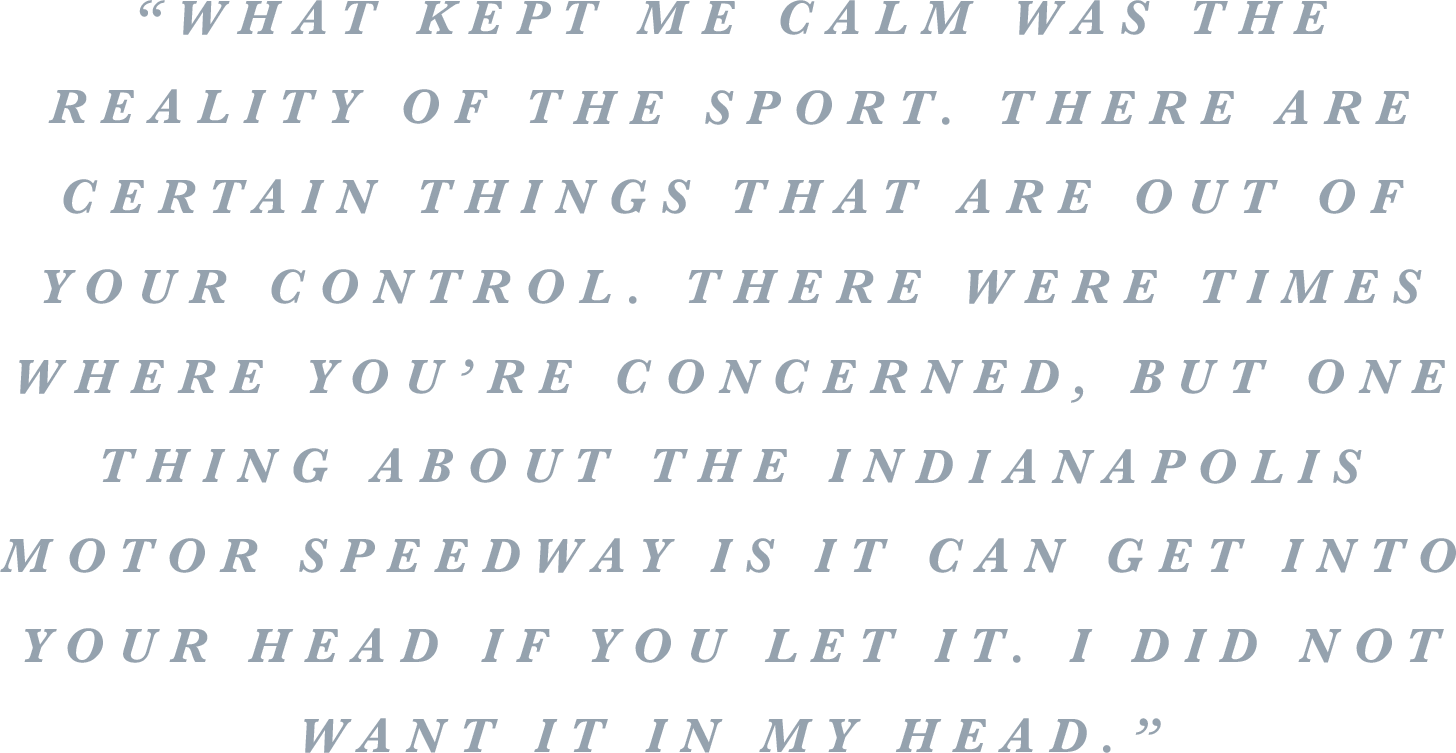

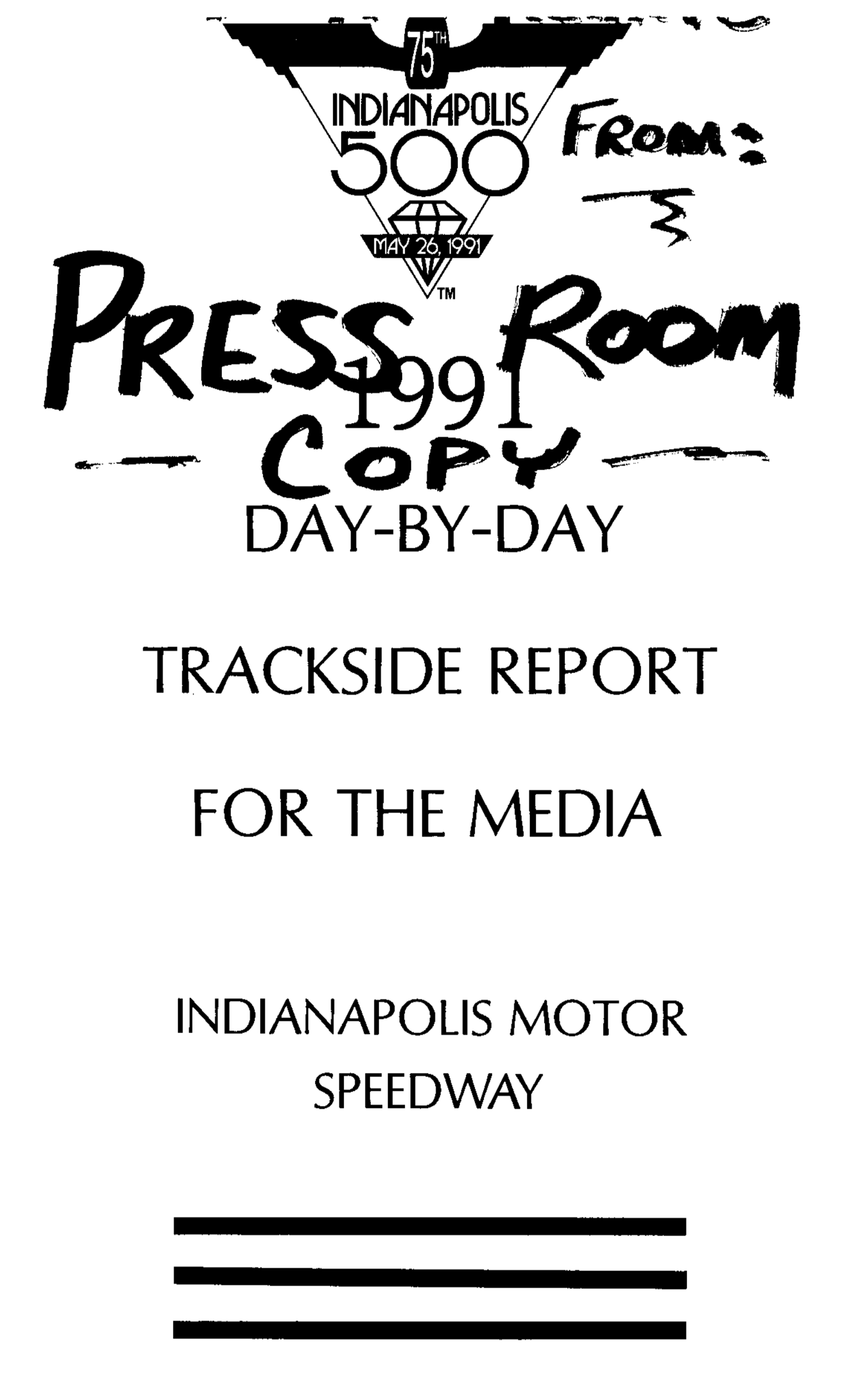
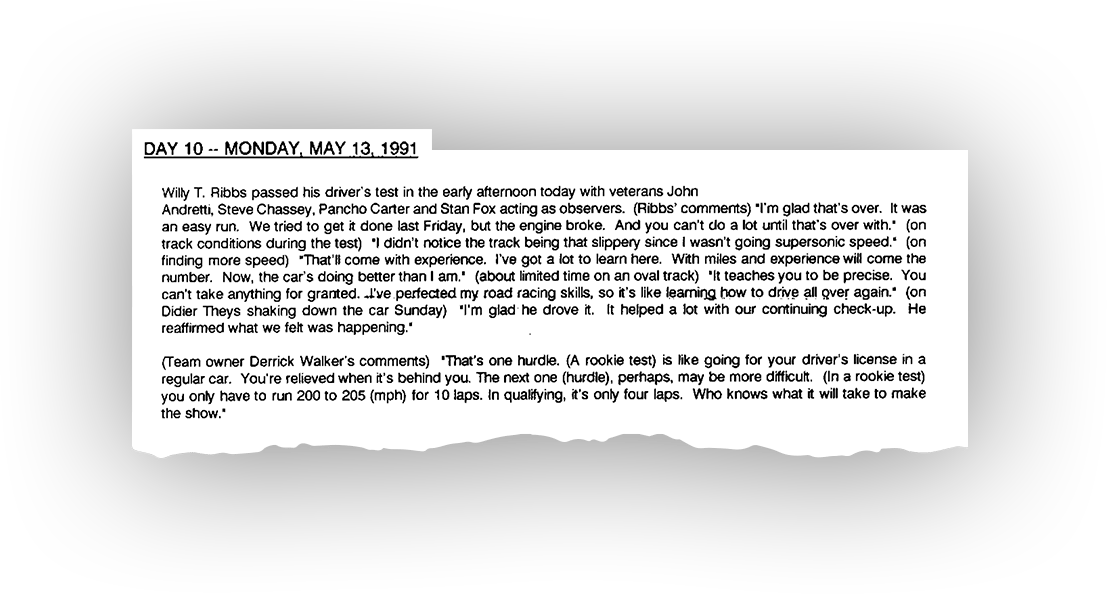

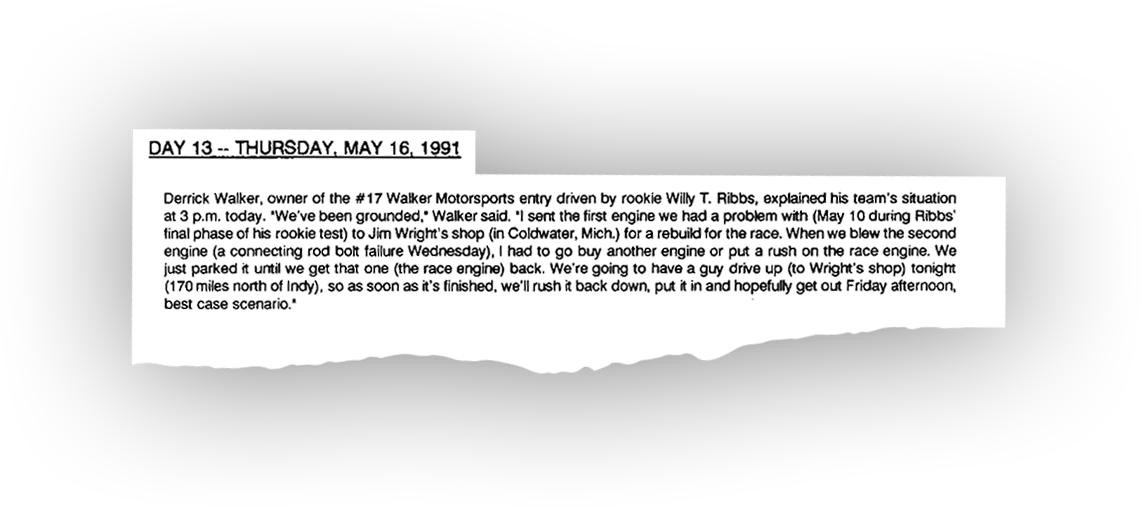
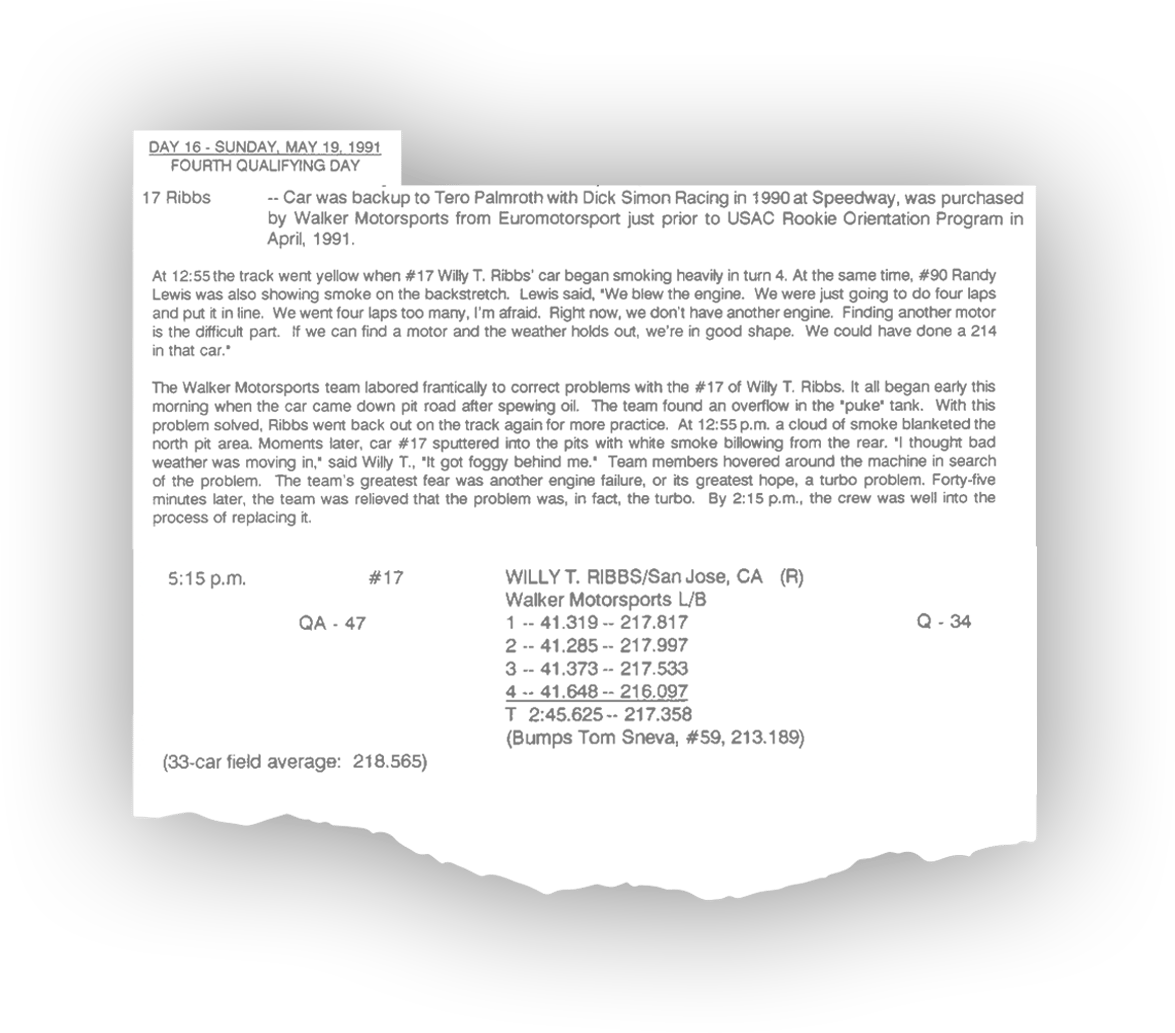
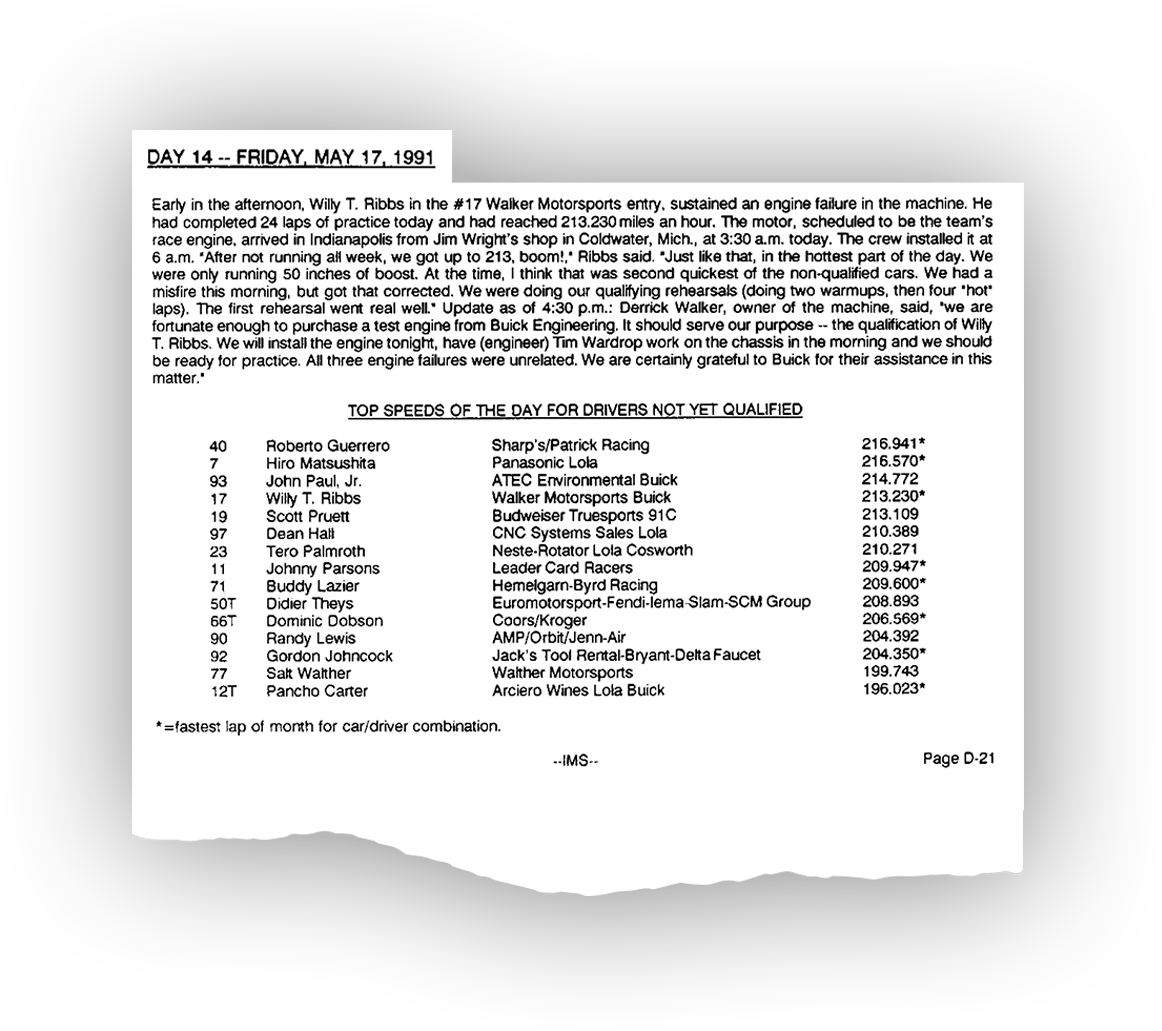
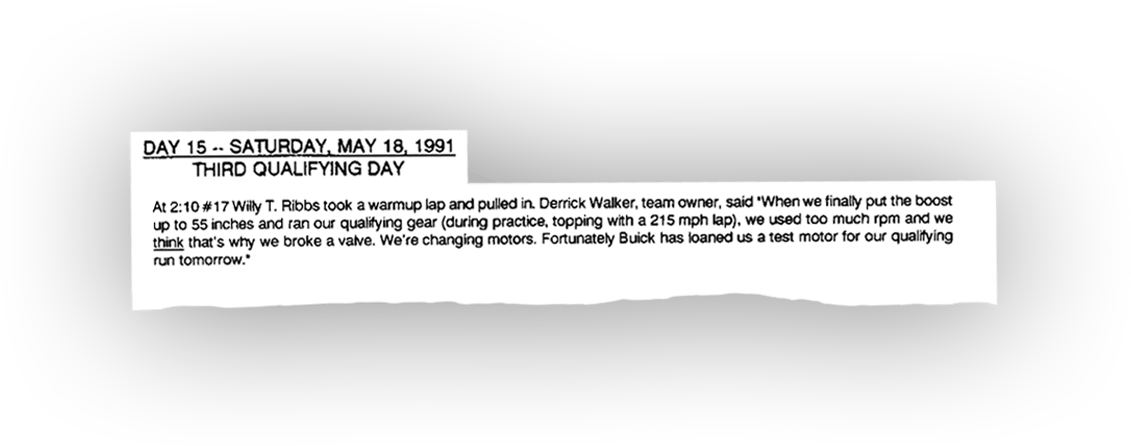
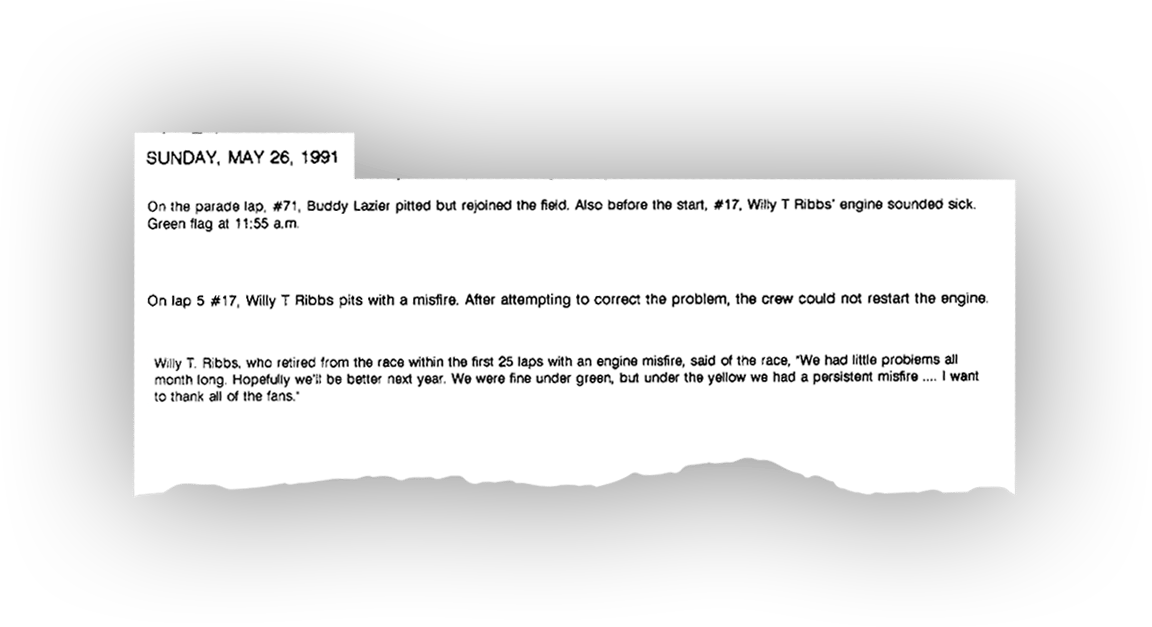
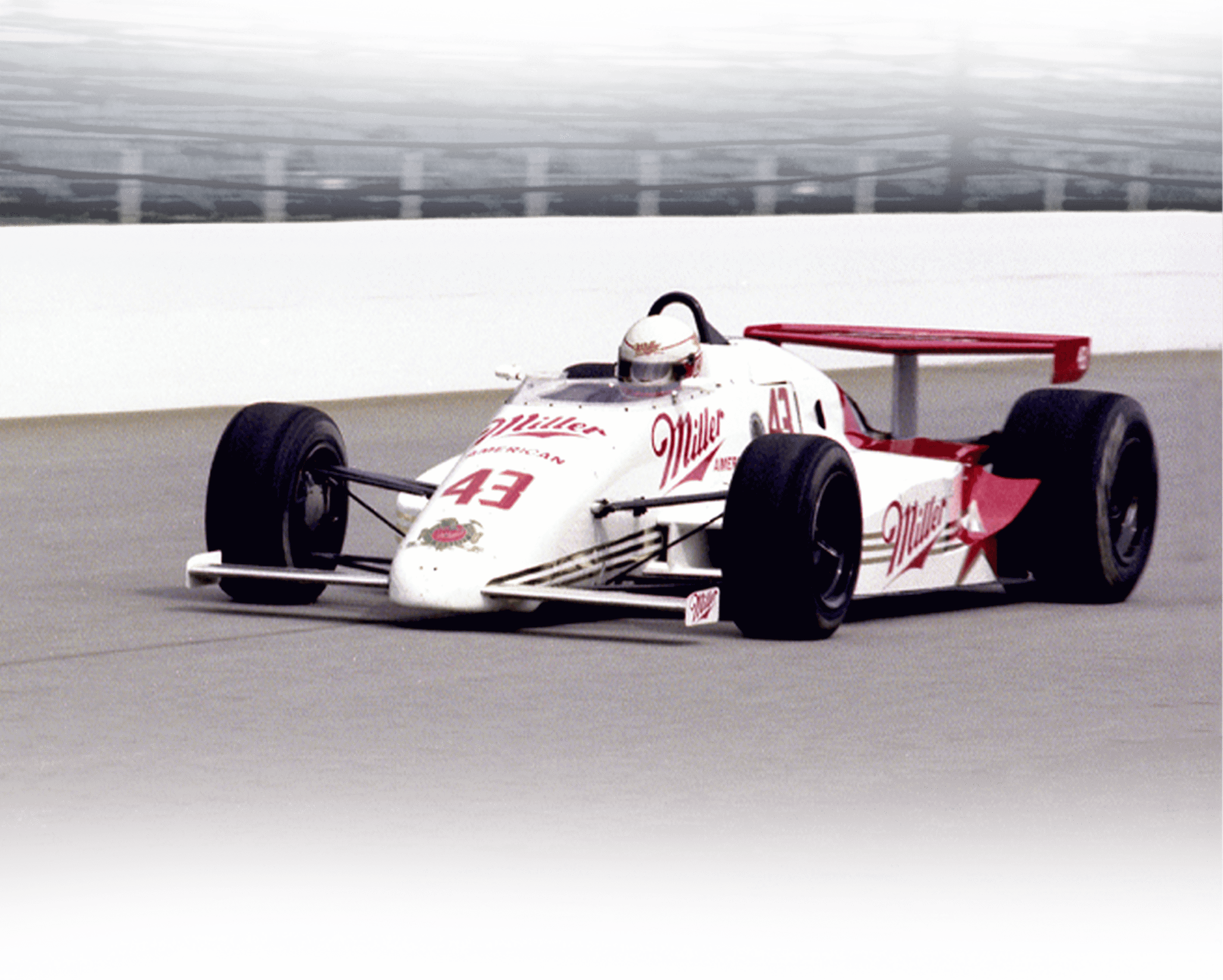


Ribbs first made history at the Indianapolis Motor Speedway in 1985 when he became the first Black man ever to drive official laps around the legendary Speedway when he attempted the Rookie Orientation Program in the AMI Racing Division entry owned by Sherman Armstrong, though it did not result in an Indy 500 qualifying attempt.
He returned in 1991 with Derrick Walker to drive the No. 17 Walker Motorsports Lola. His journey was anything but easy, and it became one of the most dramatic weeks for a single driver in “500” history.
But it’s those odds-defying accomplishments that turn moments into history and drivers into legends.
Ribbs arrived at Indianapolis in April to complete
his Rookie Orientation Program. Driving a year-old chassis that featured an old Cosworth engine, the car was lacking speed. Walker Motorsports lost the five days of on-track action as it switched to Buick engines, and Ribbs turned his first laps on
Day 6.
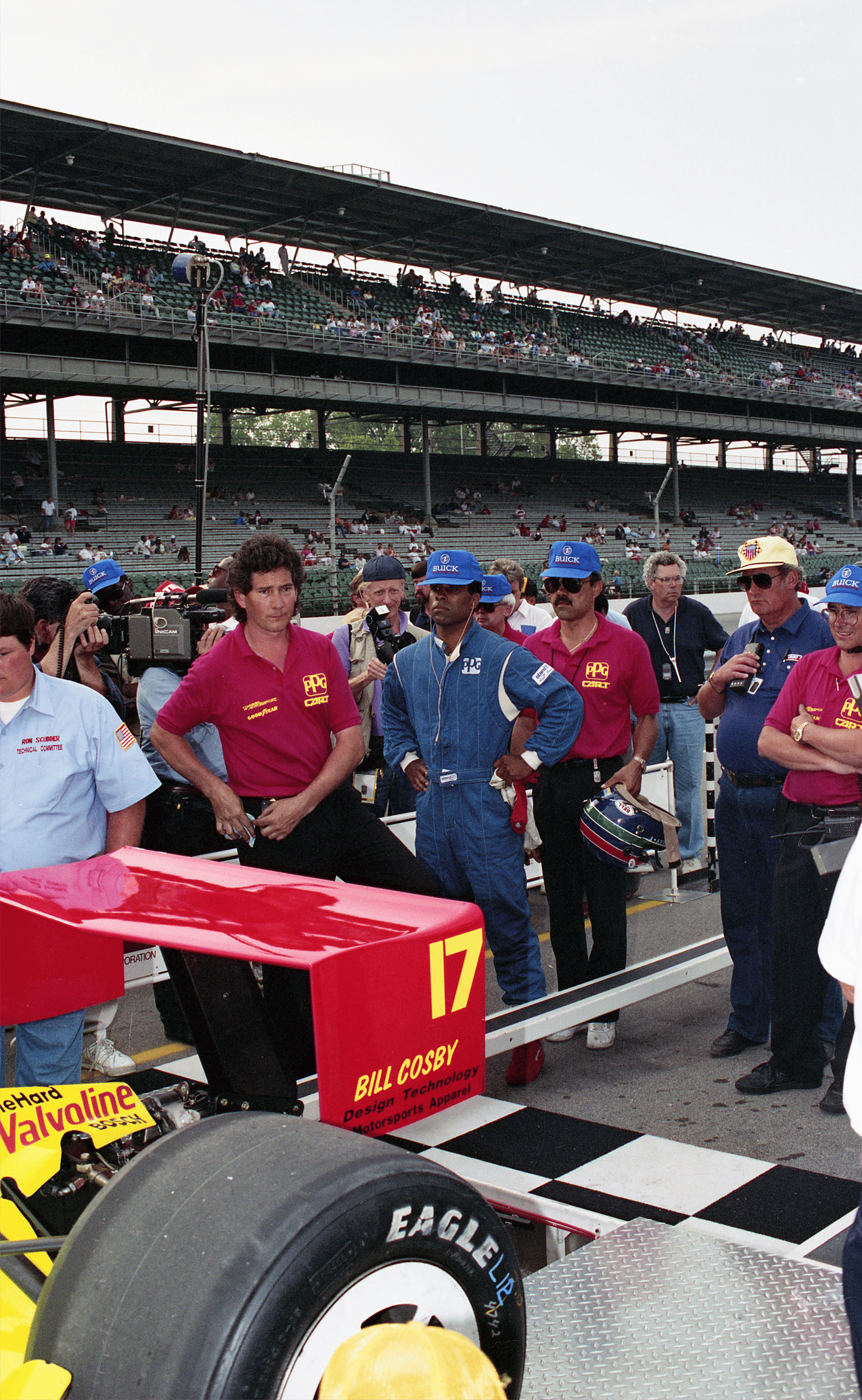
The next day, Friday, May 10, the car suffered the first of what would be six engine failures that month, including five in the next eight days. The
initial failure forced them to sit out the first weekend of qualifying.
The coming days proved to be one of the most back-and-forth, up-and-down weeks a driver could possibly withstand. One day, Ribbs would set one of the top speeds of the day. The next, a cloud of smoke trailed his yellow and red machine. Sometimes, it even happened on the same day.


– WILLY T. RIBBS

The story of Willy T. Ribbs is one that many can relate to, and certainly one that everyone can appreciate. This is a story about breaking barriers; a story about resolve, toughness and bravery.
This is the story of a modern-day trailblazer.

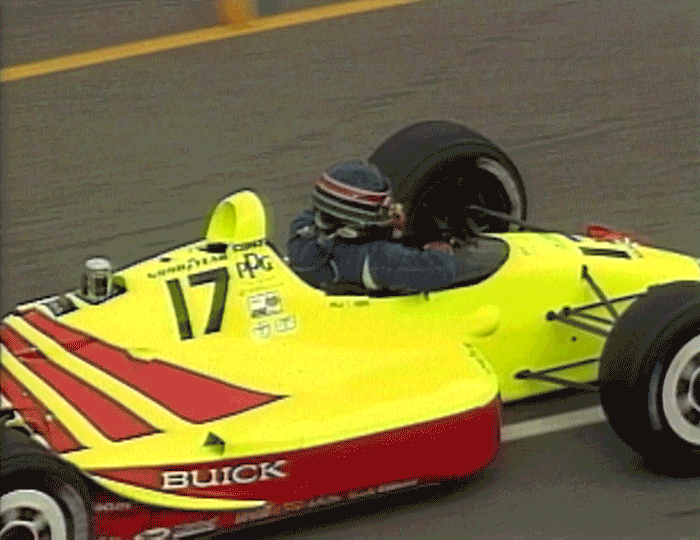
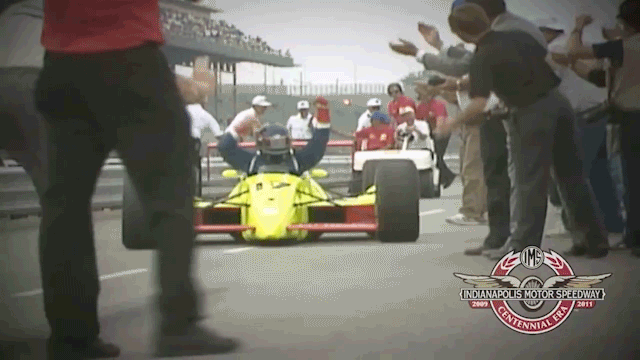



















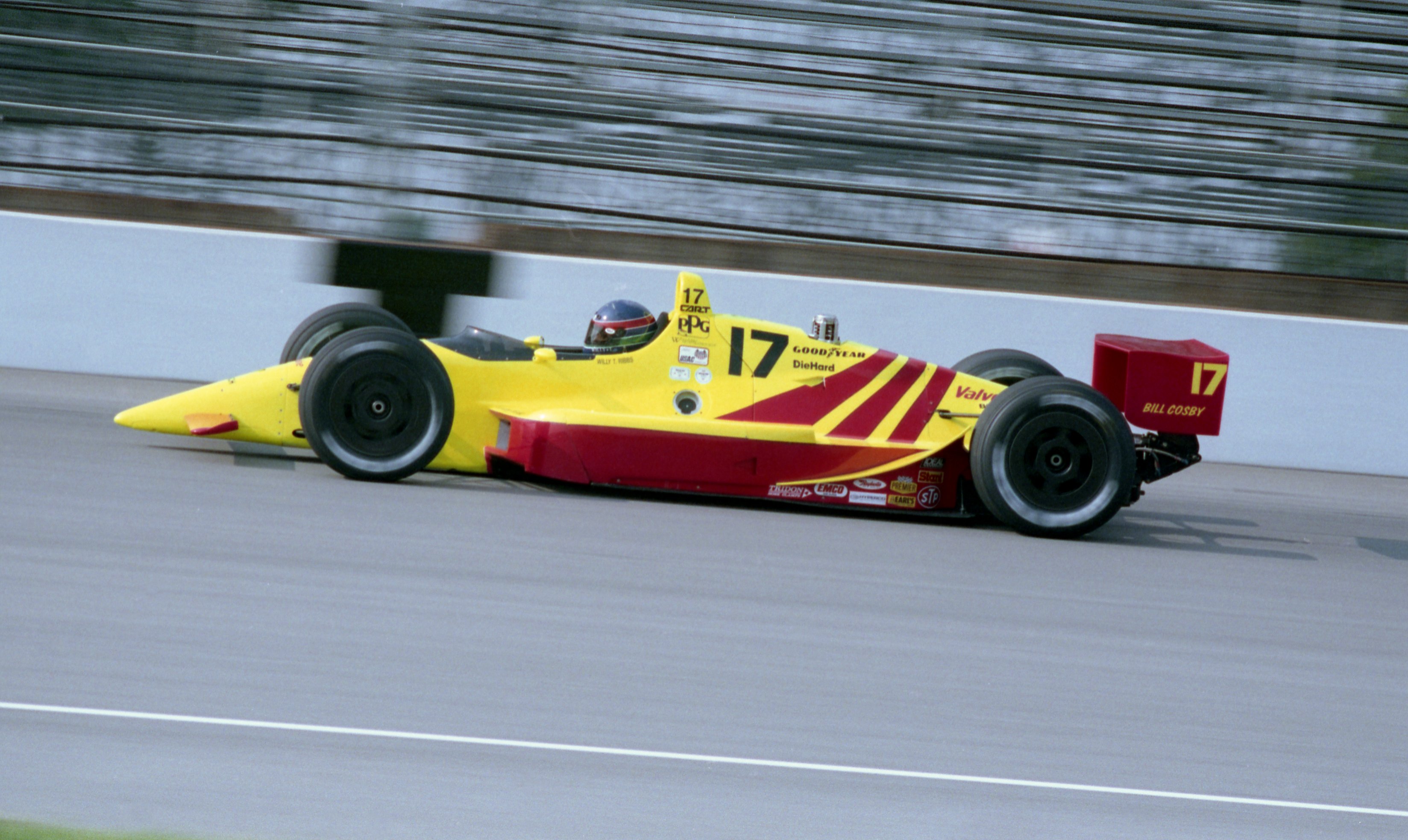

























WHERE TRADITION NEVER STOPS













